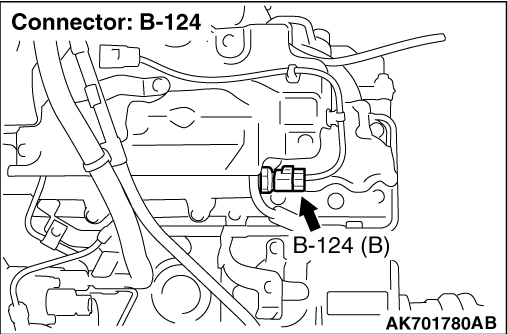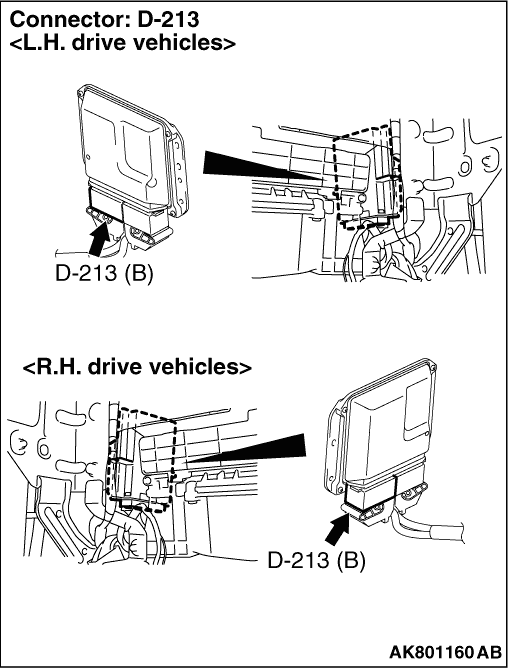|
|
- Refer to Data List Reference Table
 . .
- Item 63: Rail pressure sensor
|
|
|
Q.
Is the check result normal?
|
|
|
 Intermittent malfunction (Refer to GROUP 00 -
How to Use Troubleshooting/Inspection
Service Points -
How to Cope with Intermittent Malfunctions Intermittent malfunction (Refer to GROUP 00 -
How to Use Troubleshooting/Inspection
Service Points -
How to Cope with Intermittent Malfunctions  ). ).
|
|
|
|
|
|
Q.
Is the check result normal?
|
|
|
 Repair or replace the connector. Repair or replace the connector.
|
|
|
|
|
|
- Disconnect connector, and measure at harness side.
- Ignition switch: ON
- Voltage between terminal No. 1 and earth.
|
|
|
Q.
Is the check result normal?
|
|
|
- Measure engine-ECU terminal voltage.
- Ignition switch: ON
- Voltage between terminal No. 70 and earth.
|
|
|
Q.
Is the check result normal?
|
|
|
Q.
Is the check result normal?
|
|
|
 Repair or replace the connector. Repair or replace the connector.
|
|
|
|
|
|
- Check power supply line for short circuit.
|
|
|
Q.
Is the check result normal?
|
|
|
 Repair the damaged harness wire. Repair the damaged harness wire.
|
|
|
|
|
|
- Refer to Data List Reference Table
 . .
- Item 63: Rail pressure sensor
|
|
|
Q.
Is the check result normal?
|
|
|
 Intermittent malfunction (Refer to GROUP 00 -
How to Use Troubleshooting/Inspection
Service Points -
How to Cope with Intermittent Malfunctions Intermittent malfunction (Refer to GROUP 00 -
How to Use Troubleshooting/Inspection
Service Points -
How to Cope with Intermittent Malfunctions  ). ).
|
|
|
|
|
|
 Replace the engine-ECU. When the engine-ECU is replaced, write the chassis number
(Refer to GROUP 00 -
Precautions Before Service -
How to Perform Chassis Number
Writing Replace the engine-ECU. When the engine-ECU is replaced, write the chassis number
(Refer to GROUP 00 -
Precautions Before Service -
How to Perform Chassis Number
Writing  ). After replacing the engine-ECU, register the injector identification
code and learn fuel injection (Refer to GROUP 00 -
Precautions Before Service -
What
The Common Rail Engine Learns ). After replacing the engine-ECU, register the injector identification
code and learn fuel injection (Refer to GROUP 00 -
Precautions Before Service -
What
The Common Rail Engine Learns  ). After registering the injector
identification code, the vehicle equipped with the closed type DPF carries out the forcible
DPF regeneration. (Refer to GROUP 17 -
Diesel Particulate Filter (DPF) System -
Forcible
DPF Regeneration ). After registering the injector
identification code, the vehicle equipped with the closed type DPF carries out the forcible
DPF regeneration. (Refer to GROUP 17 -
Diesel Particulate Filter (DPF) System -
Forcible
DPF Regeneration  ). ).
|
|
|
|
|
|
Q.
Is the check result normal?
|
|
|

Check intermediate connector B-127, and repair
if necessary. If intermediate connector is normal, check and repair harness between B-124 (terminal
No. 1) rail pressure sensor connector and D-213 (terminal No. 70) engine-ECU connector.
- Check power supply line for open circuit.
|
|
|
|
|
|
 Repair or replace the connector. Repair or replace the connector.
|
|
|
|
|
|
- Disconnect connector, and measure at harness side.
- Ignition switch: ON
- Resistance between terminal No. 3 and earth.
|
|
|
OK: Continuity (2 Ω
or less)
|
|
|
Q.
Is the check result normal?
|
|
|
Q.
Is the check result normal?
|
|
|
 Repair or replace the connector. Repair or replace the connector.
|
|
|
|
|
|
- Check earthing line for damage.
|
|
|
Q.
Is the check result normal?
|
|
|
 Repair the damaged harness wire. Repair the damaged harness wire.
|
|
|
|
|
|
- Use special tool test harness (MB991658) to connect connector, and measure
at pick-up harness.
- Engine: Idling (after warming up)
- Voltage between terminal No. 2 and earth.
|
|
|
Q.
Is the check result normal?
|
|
|
Q.
Is the check result normal?
|
|
|
 Repair or replace the connector. Repair or replace the connector.
|
|
|
|
|
|
- Check output line for short circuit.
|
|
|
Q.
Is the check result normal?
|
|
|
 Repair the damaged harness wire. Repair the damaged harness wire.
|
|
|
|
|
|
- Check output line for damage.
|
|
|
Q.
Is the check result normal?
|
|
|
 Repair the damaged harness wire. Repair the damaged harness wire.
|
|
|
|
|
|
- Measure engine-ECU terminal voltage.
- Engine: Idling (after warming up)
- Voltage between terminal No. 64 and earth.
|
|
|
Q.
Is the check result normal?
|
|
|
Q.
Is the check result normal?
|
|
|

Check intermediate connector B-127, and repair
if necessary. If intermediate connector is normal, check and repair harness between B-124 (terminal
No. 2) rail pressure sensor connector and D-213 (terminal No. 64) engine-ECU connector.
- Check output line for open circuit and damage.
|
|
|
|
|
|
 Repair or replace the connector. Repair or replace the connector.
|
|
|
|
|
|
Q.
Is the check result normal?
|
|
|
 Repair or replace the connector. Repair or replace the connector.
|
|
|
|



 Intermittent malfunction (Refer to GROUP 00 -
How to Use Troubleshooting/Inspection
Service Points -
How to Cope with Intermittent Malfunctions
Intermittent malfunction (Refer to GROUP 00 -
How to Use Troubleshooting/Inspection
Service Points -
How to Cope with Intermittent Malfunctions  ).
). Go to Step 2 .
Go to Step 2 . Go to Step 3 .
Go to Step 3 . Repair or replace the connector.
Repair or replace the connector. Go to Step 9 .
Go to Step 9 .  Go to Step 4 .
Go to Step 4 .  Go to Step 8 .
Go to Step 8 . Go to Step 5 .
Go to Step 5 . Go to Step 6 .
Go to Step 6 .  Repair or replace the connector.
Repair or replace the connector. Go to Step 7 .
Go to Step 7 . Repair the damaged harness wire.
Repair the damaged harness wire. Intermittent malfunction (Refer to GROUP 00 -
How to Use Troubleshooting/Inspection
Service Points -
How to Cope with Intermittent Malfunctions
Intermittent malfunction (Refer to GROUP 00 -
How to Use Troubleshooting/Inspection
Service Points -
How to Cope with Intermittent Malfunctions  ).
).
 Repair or replace the connector.
Repair or replace the connector. Go to Step 12 .
Go to Step 12 .  Go to Step 10 .
Go to Step 10 .  Go to Step 11 .
Go to Step 11 . Repair or replace the connector.
Repair or replace the connector. Go to Step 7 .
Go to Step 7 . Repair the damaged harness wire.
Repair the damaged harness wire. Go to Step 16 .
Go to Step 16 . Go to Step 13 .
Go to Step 13 . Go to Step 14 .
Go to Step 14 . Repair or replace the connector.
Repair or replace the connector. Go to Step 15 .
Go to Step 15 . Repair the damaged harness wire.
Repair the damaged harness wire. Go to Step 16 .
Go to Step 16 . Repair the damaged harness wire.
Repair the damaged harness wire. Go to Step 18 .
Go to Step 18 .  Go to Step 17 .
Go to Step 17 . 
 Repair or replace the connector.
Repair or replace the connector. Go to Step 7 .
Go to Step 7 . Repair or replace the connector.
Repair or replace the connector.